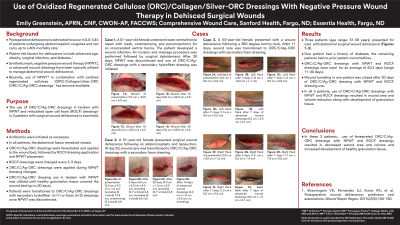Case Series/Study
(CS-067) Use of Oxidized Regenerated Cellulose (ORC)/Collagen/Silver-ORC Dressings with Negative Pressure Wound Therapy in Dehisced Surgical Wounds

Postoperative dehiscence is estimated to occur in 0.5-3.4% of patients undergoing abdominopelvic surgeries and can carry up to a 40% mortality rate.1 Patient risk factors for dehiscence include advanced age, obesity, surgical infection, and diabetes.1 Synthetic mesh, negative pressure wound therapy (NPWT), or advanced wound dressings have been typically utilized to manage abdominal wound dehiscence. Recently, use of NPWT* in combination with oxidized regenerated cellulose (ORC)/collagen/silver-ORC (ORC/C/Ag-ORC)† dressings has become available. The use of ORC/C/Ag-ORC dressings in tandem with NPWT and reticulated open cell foam (ROCF) dressings‡ in 3 patients with surgical wound dehiscence is examined.
Methods: Antibiotics were initiated as necessary. In all patients, the abdominal fascia remained closed. ORC/C/Ag-ORC dressings were fenestrated and applied to the wound bed, followed by NPWT placement. ROCF dressing changes occurred every 2-3 days. ORC/C/Ag-ORC dressings were applied during NPWT dressing changes. ORC/C/Ag-ORC dressing use in tandem with NPWT was utilized until healthy granulation tissue covered the wound bed (up to 30 days). Patients were transitioned to ORC/C/Ag-ORC dressings with secondary hydrofiber or foam dressings.
Results: Three patients (age range 51-58 years) presented for care with abdominal surgical wound dehiscence. One patient had a previous history of diabetes, the remaining patients had no prior patient comorbidities. In all 3 patients, use of ORC/C/Ag-ORC dressing with NPWT resulted in wound area and volume reduction along with development of healthy granulation tissue. Wound tunneling in one patient was closed after 20 days of ORC/C/Ag-ORC dressing with NPWT use. ORC/C/Ag-ORC dressings with NPWT were utilized for an average of 20.3 days (range 11-30 days). After NPWT was discontinued, all patients were transitioned to ORC/C/Ag-ORC dressing with a hydrofiber (n=1) or foam (n=2) secondary dressing.
Discussion: Wound area and volume reduction along with development of healthy granulation tissue were observed in these 3 patients using fenestrated ORC/C/Ag-ORC dressings in conjunction with NPWT.
Trademarked Items: *3M™ ActiV.A.C.™ Therapy System; †3M™ Promogran Prisma™ Collagen Matrix with ORC and Silver; ‡3M™ V.A.C.® Granufoam™ Dressing (3M Health Care, St. Paul, MN)
References: 1. Shanmugam VK, Fernandez SJ, Evans KK, et al. Postoperative wound dehiscence: predictors and associations. Wound Repair Regen. 2015;23(2):184-190.

.png)
